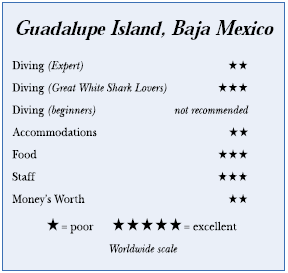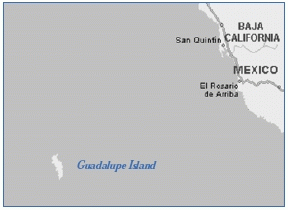Guadalupe Island, Baja MexicoContents of this Issue: Scuba Coiba, Santa Catalina, Panama Sporasub Ignores a Subscriber, but Undercurrent Gets Their Attention DAN or Your Computer? When to Fly after Diving Tech Diving, Rebreathers and Wrecks Massachusetts Wreck Plunderer Returns Artifacts Photo Gear, Rebreathers Stolen from Divers Editorial Office: Ben Davison Publisher and Editor Undercurrent 3020 Bridgeway, Suite 102 Sausalito, CA 94965 searching for the great white from the March, 2006 issue of Undercurrent
Dear Reader: Visions of great whites breeching out of the ocean to gorge on helpless northern elephant seal pups captured my imagination, so I was thrilled when a group of friends decided to dive with great whites off Isla Guadalupe, Mexico, a 175-mile boat ride from San Diego to the island west of Baja California. On the second day, when a crewmember shouted “We’ve got shark!,” it was a welcome cry. We had been skunked our first day. My first view was a 15-foot female who cruised by the cage without the least bit of interest. But, I still found it thrilling as I endlessly clicked my camera shutter. Owners and captains Shane Slaughter and John Conniff turn their 80-ft. fishing boat, the MV Islander, into a shark diving craft between August and December. They run five-day diving charters –– using up two days in transit –– primarily for Patric Douglas’ Absolute Adventures, whose trip we had joined. After we boarded in San Diego and were directed randomly to cabins, Captain Shane introduced the seven-man crew and gave us an unusual safety briefing. He cautioned about walking around the deck after dark. Should a “man overboard” emergency occur, immediately toss debris like coffee cups and other garbage to create a chum drift line to direct the boat back to the overboard passenger. We then motored 23 hours, an endless rock and roll, with several divers suffering degrees of seasickness. Just after sunrise, the waters settled as the 98-square mile island, rising to 4200 ft., came into view. Colorful red volcanic layers are reminiscent of the Grand Canyon. Freshwater springs support a community of trees and plants – – and goats, brought by early settlers, who no longer live here. The crew lowered two 4x10 ft wide cages with an electronic boom near the stern, three feet below the surface. A pump chummed fish meal into the water, quickly attracting scad mackerel and top smelt. They floated two six-pound skipjacks on buoys on each side of the cages. Shark master Luke Tipple explained that they keep the bait away from the two-foot camera aperture around the cage. “The sharks will come close and eyeball you, but we don’t want them coming directly toward the cage for the bait.” Yet for three days the sharks, in 100 ft. visibility, hardly came in for a close-up view. When sharks were around, an hour seemed like minutes; otherwise, waiting in the cage got boring and cold. And no hot shower after the dive. We were asked to use the frigid freshwater shower on the starboard side to conserve water. After being skunked the first day, I awoke to cloud cover and rolling seas the next morning. The 69-degree water was warmer than the air. Swimming gracefully, a 15-foot great white female with mating scars circled the boat. Then a smaller male appeared. My adrenaline rushed, but they had little interest in us. They continued circling until one launched into high gear to grab the skipjack. We all had the thrill of seeing four great whites on this day. To join the expedition, no dive certification is required, and no gear other than a mask, booties, and 7-mil wetsuit with hood. But, it takes some bravery, since one must jump from the boat through the four-foot open ceiling of the bouncing cage in the presence of great whites. Several experienced divers were badly bruised and one injured a foot after smashing into the side of the bucking cage opening. Four divers, in two shifts, were assigned to each of two cages every hour.
We breathed surface-supplied compressed air through Scubapro regulators and wore
harness-type vests pocketed with up to 40 pounds of weight so we could stand or sit in the cage. The MV/Islander carries 30 passengers in two or three bunk cabins. The Absolute Adventure web site says the craft features “private air conditioned staterooms and washbasins, plus every other diving amenity you or your groups will need. . .If you’re looking for comfort, attention to detail, corporate incentive, and or a unique meeting/strategy space this is the vessel for you.” Baloney. The small, basic, musty cabins, without bathrooms or closets, had insufficient space for two divers to stand at the same time. The bunks were stacked so tightly I couldn’t sit on the bed. The small washbasin had inadequate light for shaving or inserting contact lenses. No soap, no waste basket, no housekeeping. And, you had to bring your own towel –– or find someone who brought two. A flight above the cabins, two bathrooms with temperamental hot-water showers that overflowed were shared by 17 divers plus the crew. Droppings on the staircase were evidence that we had a rat in the house. On the top deck, the padded compressor covering could be used to stretch out, or one could read in one of several deck chairs. Divers were welcomed into the well-equipped wheelhouse. A noisy compressor ran all night to fill the next day’s tanks. When the boat was running, the automatic pilot beeped continuously on the starboard side of the salon, interrupting the sleep of those in nearby cabins. Four leather-covered booths seated six passengers in the salon. Paul Grebetz
prepared abundant, hearty and heavy cuisine, usually topped with rich gravy or
garlic or butter. Several vegetarians who had made their restrictions known
beforehand were unhappy that he served no protein options. Last October, Guadalupe was designated a biosphere preserve to preserve the great whites, whose jaws sell for $10,000 a pop on eBay. According to Shane, fishing boats were arriving with makeshift cages. Divers were swimming and photographing sharks outside cages. The Mexican government, wanting to protect the shark, put regulations in place. Fishing is no longer allowed. The government allegedly does not want sharks to associate diving boats and cages with people. Our final day, viewing, as usual, began at 7:30 a.m. A single great white appeared at 10 a.m. For most of the day he swam aimlessly under the boat at a depth just out of camera focus range, a real tease. Having waited 25 years for the experience, I was excited to finally see great white sharks, though few and distant. Undercurrent readers have reported much better viewing on other trips and on other vessels, so whether the whites weren’t present, weren’t hungry, or our boat chased them away, I don’t know. So, unless your life isn’t complete until you see a great white underwater, you may be disappointed, not only in the action, but, if you’re on this boat, in the entire trip. — G.S.
|

I want to get all the stories! Tell me how I can become an Undercurrent Online Member and get online access to all the articles of Undercurrent as well as thousands of first hand reports on dive operations world-wide
| Home | Online Members Area | My Account |
Login
|
Join
|
| Travel Index |
Dive Resort & Liveaboard Reviews
|
Featured Reports
|
Recent
Issues
|
Back Issues
|
|
Dive Gear
Index
|
Health/Safety Index
|
Environment & Misc.
Index
|
Seasonal Planner
|
Blogs
|
Free Articles
|
Book Picks
|
News
|
|
Special Offers
|
RSS
|
FAQ
|
About Us
|
Contact Us
|
Links
|
3020 Bridgeway, Ste 102, Sausalito, Ca 94965
All rights reserved.

 Exiting the cage was
awkward, perhaps unsafe. I balanced on
metal steps of the rocking cage before
precariously stepping on top, then made
a giant stride onto the boat, with the
assistance of a wrist grab. Don’t get
out of the cage without their help,
lest you fall into 200 feet of water
dressed in a 40 pound weighted jacket,
with no emergency release. If a shark
breached the cage, they advised us to
drop weights (how?) and exit through
an emergency door opened by pulling a
yellow cable, though I never saw the
escape route on the other side.
Exiting the cage was
awkward, perhaps unsafe. I balanced on
metal steps of the rocking cage before
precariously stepping on top, then made
a giant stride onto the boat, with the
assistance of a wrist grab. Don’t get
out of the cage without their help,
lest you fall into 200 feet of water
dressed in a 40 pound weighted jacket,
with no emergency release. If a shark
breached the cage, they advised us to
drop weights (how?) and exit through
an emergency door opened by pulling a
yellow cable, though I never saw the
escape route on the other side. When a diver requested
his steak rare on the first night,
Grebetz said “I have too many sick
people to do individual preparation.”
But he soon became cordial and jovial.
And, he baked a mean rhubarb and strawberry
pie, fresh fruit turnovers, and
bread. Mid-morning snacks were coffee
cake or chocolate chip muffins, while
late afternoon it was hot dogs with the
works or pot stickers.
When a diver requested
his steak rare on the first night,
Grebetz said “I have too many sick
people to do individual preparation.”
But he soon became cordial and jovial.
And, he baked a mean rhubarb and strawberry
pie, fresh fruit turnovers, and
bread. Mid-morning snacks were coffee
cake or chocolate chip muffins, while
late afternoon it was hot dogs with the
works or pot stickers.  Divers Compass: Patric Douglas of Absolute Adventures runs several
5-day charters late summer and through early fall. The trip
is $2500 and you’ll need to overnight in San Diego before and after
the trip ... The Holiday Inn Bayside offers a free shuttle from and
to the airport and while it’s across the street from the dock, it
provides shuttle service so you don’t lug gear ... Special rates
are around $100/night ... You can rent dive gear and wet suits from
the Martin Graf Dive School for $50-$100. They pick up and deliver
to the boat. Arrange in advance ... Our group of 17 was joined by
a father and son, a former Everest climber, and two lovebirds from the Bay area.
Absolute Adventures:
Divers Compass: Patric Douglas of Absolute Adventures runs several
5-day charters late summer and through early fall. The trip
is $2500 and you’ll need to overnight in San Diego before and after
the trip ... The Holiday Inn Bayside offers a free shuttle from and
to the airport and while it’s across the street from the dock, it
provides shuttle service so you don’t lug gear ... Special rates
are around $100/night ... You can rent dive gear and wet suits from
the Martin Graf Dive School for $50-$100. They pick up and deliver
to the boat. Arrange in advance ... Our group of 17 was joined by
a father and son, a former Everest climber, and two lovebirds from the Bay area.
Absolute Adventures: 